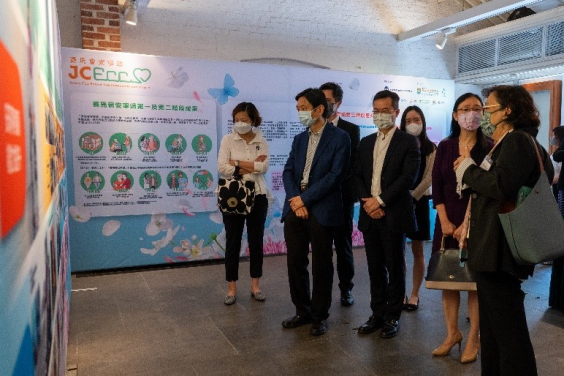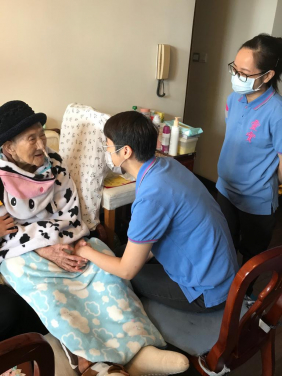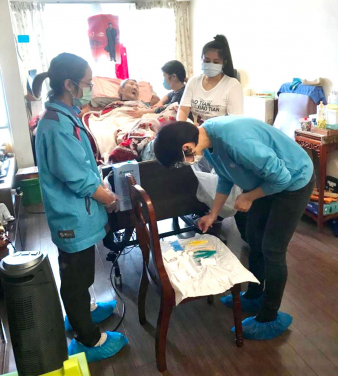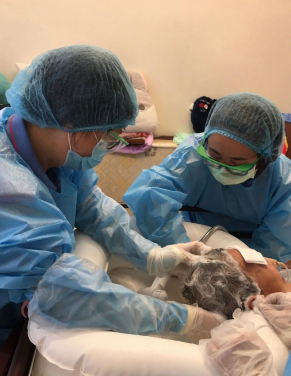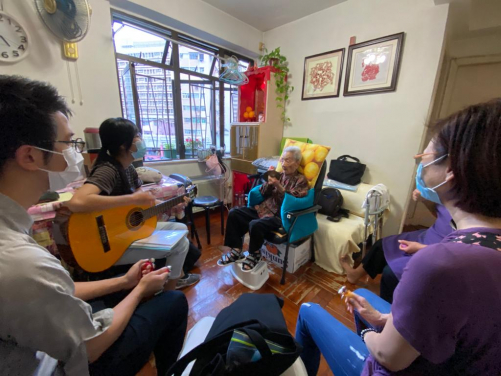Media
Jockey Club End-of-Life Community Care Project effectively supports patients with terminal illness during the pandemic
08 Jul 2022
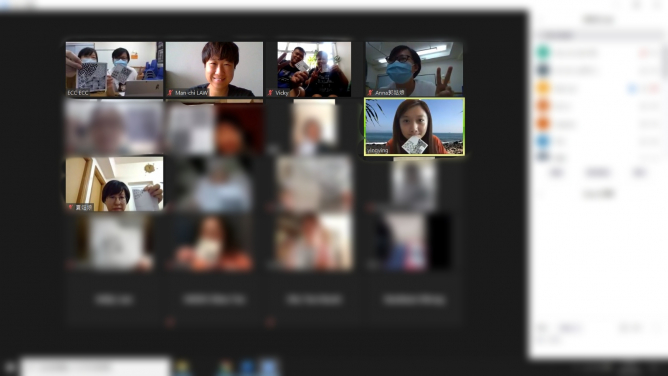
Vicky’s mother was motivated to eat after using the adjustable mattress suggested by the service team
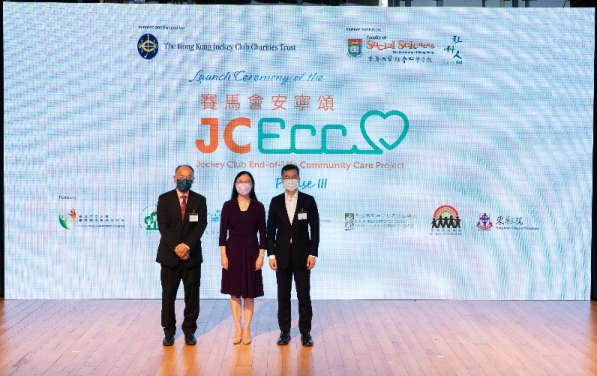
(From left) The Hong Kong Jockey Club and Professor Paul Yip, Acting Dean of Social Sciences of HKU, Ms Alice Lau, JP, Permanent Secretary for Labour and Welfare, Labour and Welfare Bureau, HKSAR Government and Mr. Leong Cheung, Executive Director, Charities & Community are the officiating guests of the Jockey Club End-of-Life Community Care Project Phase III Launch Ceremony.
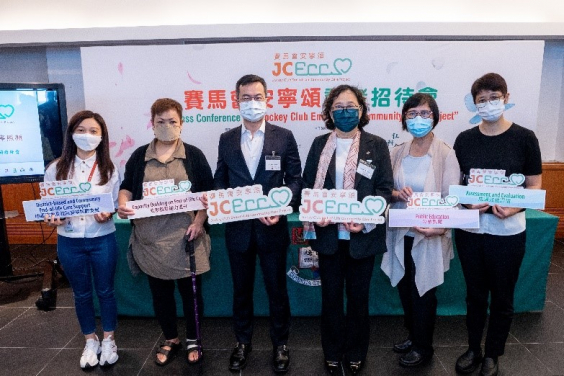
Press Conference for “Jockey Club End-of-Life Community Care Project”: (From left) Ms. Ho, representative of JCECC “Life Rainbow” End-of-Life Care Services of The Hong Kong Society for Rehabilitation; Vicky, family member of service recipient; Mr. Leong Cheung, Executive Director, Charities and Community, The Hong Kong Jockey Club; Professor Amy Chow, Head, Department of Social Work and Social Administration, Faculty of Social Sciences, HKU & Project Director; Ellen, family member of service recipient; and Ms. Cheung, representative of JCECC “Hospice at Home” of the Haven of Hope Sister Annie Skau Holistic Care Centre.
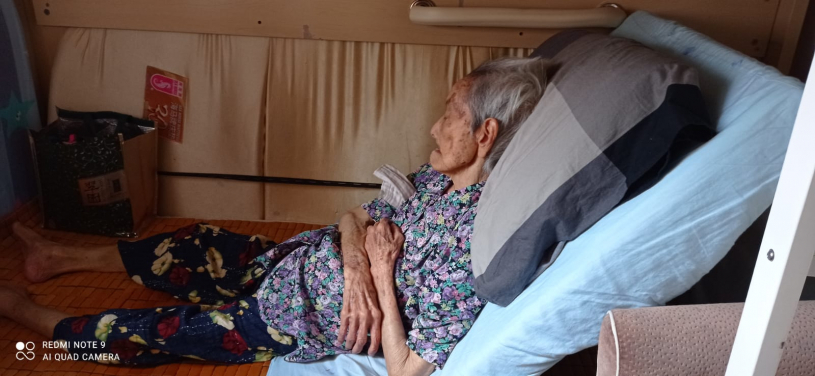
Vicky’s mother was motivated to eat after using the adjustable mattress suggested by the service team

Vicky’s mother was motivated to eat after using the adjustable mattress suggested by the service team

(From left) The Hong Kong Jockey Club and Professor Paul Yip, Acting Dean of Social Sciences of HKU, Ms Alice Lau, JP, Permanent Secretary for Labour and Welfare, Labour and Welfare Bureau, HKSAR Government and Mr. Leong Cheung, Executive Director, Charities & Community are the officiating guests of the Jockey Club End-of-Life Community Care Project Phase III Launch Ceremony.
- 1 / 9
- 2 / 9
- 3 / 9
- 4 / 9
- 5 / 9
- 6 / 9
- 7 / 9
- 8 / 9
- 9 / 9
The ranking of Hong Kong in the Quality of Death Index, drastically leaped from the 22nd among 80 places around the world in 2015[1] to the 9th among 81 in 2021[2],[3]. The Hong Kong Jockey Club Charities Trust (HKJC Charities Trust) initiated and funded to launch the Jockey Club End-of-Life Community Care (JCECC) Project in 2016, which is believed to be one of the main drivers of this impressive rise together with the concerted efforts of the Government and other stakeholders. To continue the good work in Hong Kong, the HKJC Charities Trust approved an additional funding of nearly HK$264 million to launch the third phase of the project from 2022 to 2025, adding up to a total funding of around HK$520 million.
Ms. Alice Lau, JP, Permanent Secretary for Labour and Welfare of the Government of the HKSAR, Mr. Leong Cheung, Executive Director, Charities and Community from The Hong Kong Jockey Club and Professor Paul Yip, Acting Dean of Social Sciences of The University of Hong Kong (HKU) officiated the Project’s Phase III launch ceremony at Jao Tsung-I Academy. Speaking at the ceremony, Mr. Cheung said, “The Club is glad to see that JCECC has yielded higher positive impact during this critical moment of Hong Kong, and hope that end-of-life care services could be regularised in the future to address community needs.”
The research team, led by Professor Amy Chow, Director of JCECC Project and Head of Department of Social Work and Social Administration, Faculty of Social Sciences, HKU analysed the needs and reactions of the service users of the “Integrated Community End-of-life Support Team” (ICEST) in six distinct periods of the pandemic. Patients with terminal illnesses were found to have different levels of physical, emotional, practical and social needs. Professor Chow said, “The pandemic and related social distancing policies posed extra challenges to these families. As patients spent more time at home during their end of life under the pandemic, community end-of-life care offered appropriate and timely support. Although the family members had to offer more care support, the caregiver strain level was found to be lower during the first to fourth waves of the pandemic.”
With the social distancing policies during the pandemic, the time of using phone contact or online platform to maintain the service increased from 34.2% to 43.1%. The service teams still maintained face-to-face contact as far as possible. Commented by Professor Chow, “The effectiveness of the services was not affected by the changed mode of care. The services were found to be more effective than the pre-pandemic period in major aspects. The team carried out Social Return on Investment Analysis and found that the output of EoL care during the pandemic periods reached as high as 6.73 times of the input, compared to the 3.33 times during the pre-pandemic level.
These findings were echoed by the sharing of two beneficiaries under the JCECC Project. Ellen’s mom, Ms. Li, was suffering from advanced dementia and had been admitted to hospital twice during the pandemic. Concerning about the visitation restriction in hospitals, Ellen and her siblings felt a pressing need to plan ahead for mom’s care. They started receiving assistance from the JCECC Project: Hospice at Home programme since February 2021. The service team offered continuous nursing advice and other tangible support through phone or home visits and advance care plan discussions were also conducted. The siblings finally decided to send Ms. Li to hospital for symptom management in final weeks and were able to say goodbye to mom in a compassionate visit. Another carer, Vicky, took care of her mom who was suffering from end-stage heart failure and dementia. During the pandemic, the service team made regular phone contacts to monitor the conditions of Vicky’s mom. One time when Vicky’s mom refused to eat, the service team immediately arranged home visit and motivated Vicky’s mom to eat again. Vicky and her husband also joined the service’s online caregiver support session and found it helpful in relieving stress. Notably, Vicky also found the work from home policy during the pandemic had helped reduce her stress as she could manage both caregiving and work more flexibly. Finally, Vicky’s mother passed away peacefully at home in early 2021. Mom had a “good death” in Vicky’s eyes, which could not have been actualised without the support of the service under the JCECC project.
The press conference not only shared successful contributions and impact to the community, it also marked a new page to the JCECC Project. During the past six year, the Phase I and II of the Project continuously provided community EoL care service to patients with terminal illness at home and residential care homes for the elderly (RCHEs), offered trainings to enhance competence and capacity of health and social care professionals, frontline practitioners and volunteers, and organised public education activities to raise awareness and knowledge in building a compassionate community. As of December 2021, JCECC has already served over 3,200 end-of-life patients and 8,400 family carers, trained more than 30,000 professionals and 3,400 volunteers, and over 220,000 citizens acquired EoL care knowledge through various public education activities.
Partnering with the Faculty of Social Sciences of HKU, The Chinese University of Hong Kong Jockey Club Institute of Ageing, Hong Kong Association of Gerontology, Haven of Hope Christian Service, The Hong Kong Society for Rehabilitation, St. James’ Settlement, S.K.H. Holy Carpenter Church District Elderly Community Centre, and Tung Wah Group of Hospitals, the Trust will further promulgate community EoL care service in the third phase of JCECC. The ICEST, which is an evidence-based medical-social collaborative service model developed under the Project, will be extended to more service districts with comprehensive support offered to more EoL patients staying at home and their families. The number of RCHEs participating in JCECC will be doubled from 48 to 96 in order to serve more elderly patients and empower more frontline practitioners to deliver quality EoL care. The JCECC Project will also study the economic efficiency of the service model and factors contributing to the success of the model so as to further foster its sustainability and cost-effectiveness. Meanwhile, a multi-pronged approach will be adopted for enhancing the EoL care capacity in the community. On one hand, capacity building programmes will be offered to healthcare professionals, social workers, volunteers, and caregivers for fostering their EoL care competence. On the other hand, public education campaigns will keep on playing the role in raising public awareness on EoL care.
About “Jockey Club End-of-Life Community Care Project”
Hong Kong is facing a rapidly ageing population, and the number of elderly suffering from terminal illnesses has also escalated correspondingly. In view of the growing demand for end-of-life care services in the community, The Hong Kong Jockey Club Charities Trust approved around HK$520 million to initiate the “Jockey Club End-of-Life Community Care Project” (JCECC). Launched in 2016, the ten-year project aims at improving the quality of end-of-life care, enhancing the capacity of service providers, as well as raising public awareness.
JCECC is a multi-disciplinary, multi-institutional and cross-sectoral collaboration to help enhance end-of-life care in Hong Kong with special emphasis on the interface between social and medical systems. Service models are being developed and shaped to provide holistic support to terminally-ill elders in the community and elderly homes. The goal is to enable the city’s older people to have informed choices of care and have an improved quality of life. Please visit http://www.JCECC.hk/
For the Appendix, please click here.
For media enquiries, please contact
Mr. Alan Tang, Faculty of Social Sciences, HKU (Tel: 3917 1260 / 6023 6711; email: alantsl@hku.hk)
[1] Economist Intelligence Unit (2015). The 2015 Quality of Death Index: Ranking palliative care across the world. Retrieved from: http://www.lienfoundation.org/sites/default/files/2015%20Quality%20of%20Death%20Report.pdf
[2] Finkelstein, E. A., Bhadelia, A., Goh, C., Baid, D., Singh, R., Bhatnagar, S. & Connor, S. R. (2022). Cross Country Comparison of Expert Assessments of the Quality of Death and Dying. Journal of Pain and Symptom Management, 63(4), e419-e429. doi: https://doi.org/10.1016/j.jpainsymman.2021.12.015
[3] Duke-NUS Medical School (n.d.). Cross country Comparison of Expert Assessments of the Quality of Death and Dying 2021. Retrieved from: https://www.duke-nus.edu.sg/lcpc/quality-of-death

